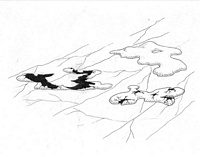|
 Diderma effusum Diderma effusum
SynonymsPhysarum effusum
BiostatusPresent in region - Indigenous. Non endemic
Images (click to enlarge)
Caption: Three small plasmodiocarps of Diderma effusum on a dead leaf. The one on the lower right is about 1 cm broad.[?
Owner: S.L. Stephenson |
Article: Stephenson, S.L. (2003). Myxomycetes of New Zealand. Fungi of New Zealand. Ngā Harore o Aotearoa 3: xiv + 238 p. Hong Kong: Fungal Diversity Press.
Description: Fruiting body a sessile sporangium or (more commonly) a plasmodiocarp, the latter usually broadly effused, gregarious, 0.5–1.5 mm broad and often up to 6 cm in maximum extent. Hypothallus membranous, white, rarely extending very far beyond the fruiting body and often inconspicuous. Peridium double, the outer layer calcareous, relatively smooth, white, the inner layer membranous, colourless, dehiscence irregular. Columella flat pulvinate, pinkish brown. Capillitium delicate, the threads colourless or pale purple, sparingly branched and anastomosing. Spores dark purple in mass, pale violaceous brown by transmitted light, almost smooth to minutely warted, 7–9 µm in diameter. Plasmodium white.
Habitat: Dead leaves and other plant debris on the forest floor.
Distribution: Considered to be cosmopolitan by Martin & Alexopoulos (1969). First reported from New Zealand by Mitchell (1992), based on a specimen collected in Dunedin. Also known from Auckland.
Notes: Typical fruitings of Diderma effusum are easily recognized by their broadly effused plasmodiocarps. Diderma chondrioderma is rather similar in appearance, but much less common in nature, although it sometimes appears on tree bark in moist chamber cultures. Sessile sporangia of D. hemisphaericum might be confused with those of D. effusum, but the presence of at least some stalked sporangia in a given fruiting is enough to distinguish this species. In northern New Zealand, Diderma effusum appears to be relatively common on decaying fronds of nikau palm (Stephenson 2003).
|